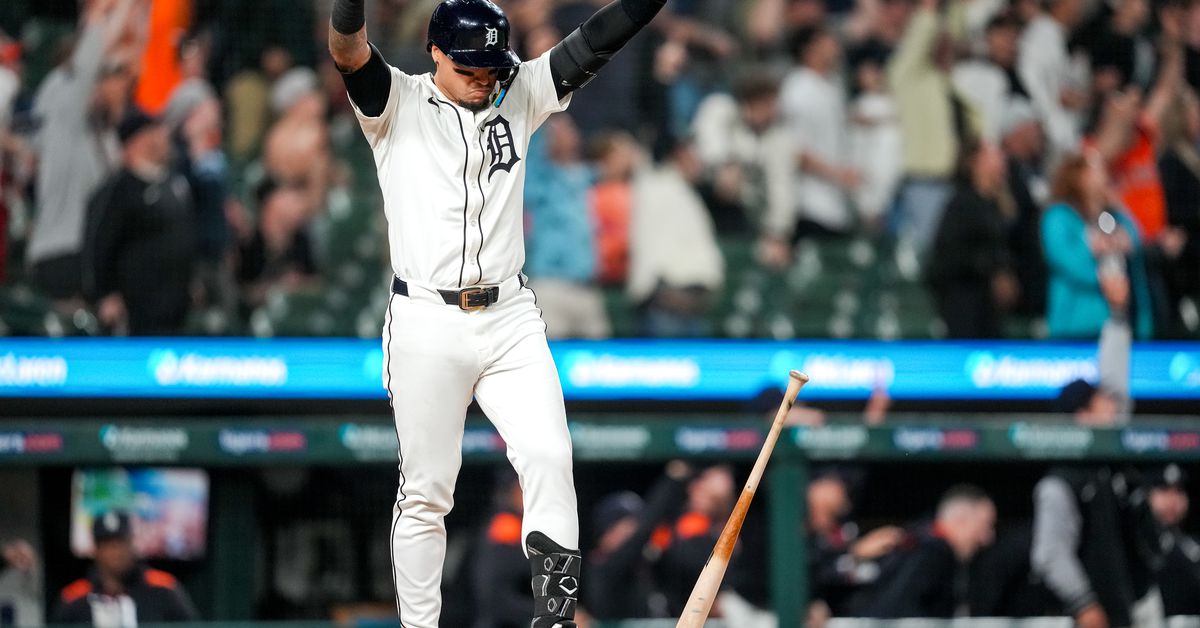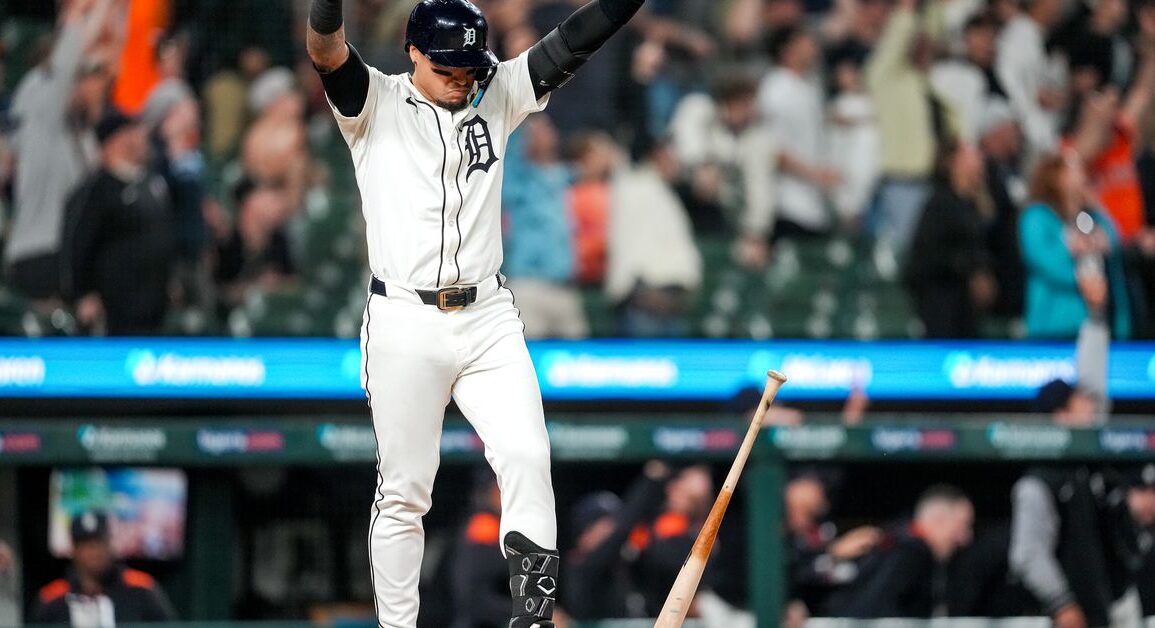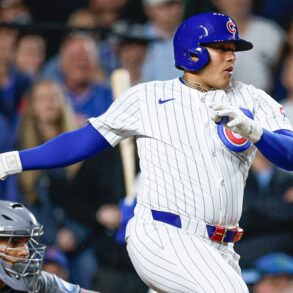
On Tuesday night, Javier Baez circled the bases after hitting a walk off two run homer to give the Detroit Tigers a 10- 9 victory over the Boston Red Sox at Comerica Park, savoring his first multi home run game as a Tiger and the second walk off blast of his career. As he jumped on home plate, ambushed by his team mates, setting off the latest euphoric ending for the Detroit team, one thing was clear to all who were watching. Javy was back and it’s a wonderful thing in Tiger land.
When the Detroit Tigers signed Baez to a six year, $140 million contract before the 2022 baseball season, expectations were that he would hit a whole lot better than the production that they got from the two time former All Star in his first three seasons in Detroit.
In parts of eight seasons with the Chicago Cubs, Baez slashed .262/ .303/ .474/ .777, averaging 24 home runs and 84 RBI per 162 games over eight seasons. In part of a season with the New York Mets after a midseason trade in 2021, he slashed .299/ .371/ .515, in what would be his hottest streak just before hitting the free agent market.
Heading into the 2022 season, the Tigers were intent on signing one of half a dozen free agent shortstops from a free agent class that included stars such as Corey Seager, Carlos Correa, and Trevor Story and when the music stopped, Baez was a Tiger. He would become the highest paid Tiger once Miguel Cabrera’s contract expired after Javy’s first season in Detroit, and there he remains atop the club’s payroll.
To say that he has been a disappointment would be an understatement. After posting a modestly disappointing .671 OPS with 17 homers in 2022, he went straight into the tank, becoming arguably baseball’s worst hitter for the next two seasons, with an OPS+ of just 63 in 2023 and 46 in 2024, hitting just nine and then six dingers, respectively.
The loss of home run power was particularly upsetting, given that Baez had hit at least 22 home runs every season for five of six seasons, the outlier being Covid shortened campaign, prior to signing with Detroit.
Bye Bye Shortstop
When the Tigers traded Jack Flaherty to the Los Angeles Dodgers, acquiring shortstop Trey Sweeney, a former first round pick in the deal, with Baez out for the season, his days in the Tigers’ infield appeared to be numbered. There were questions whether he would make the team out of spring training, and the smart money was often though to be on the under in that bet. At best, he might have been the weak side of a platoon at shortstop, or a defensive replacement seeing limited action. And that’s how the 2025 campaign began.
As luck would have it, the Tigers suffered a rash of injuries in their outfield- center field to be precise, losing Parker Meadows, then Wenceel Perez and late acquisition Manuel Margot to the injured list. They deployed a colorful mix of replacements, moving All Star Riley Greene from his corner spot on some nights, while putting super utility player Zack McKinstry or utility infielder Ryan Kreidler in the middle outfield spot.
While Kreidler proved to be adequate with the glove in the spacious grounds of Comerica Park, he was anything but at the plate, slashing .105/ .290/ .105 for a grand OPS of .400. His wRC+ was negative 10. So the Tigers had nothing to lose by giving Baez, whose athleticism has never been in doubt, a shot to play in center field. The rest, as they say, is history.
Not only did Baez take to the outfield like a fish to water, but he regained his form at the plate and has hit better than at any time since arriving in the Motor City. Baez has hit over .300, which he has never done in a dozen seasons in his career, with an OPS over .800 and a wRC+ of 130, second only to Spencer Torkelson on the team.
So here is a two time all star, former Gold Glove shortstop, bumped off his position and given up for burnt toast, batting ninth and playing center field and slugging as well as he has done at any time in his career.
Behind the Numbers
Let’s dig into some peripheral numbers to see if we can attribute Javy’s resurgence to something statistical. We know that he changed his setup, closing his stance more and stopped resting the bat over his right shoulder, getting it in a more vertical position primed to get through the hitting zone more efficiently. Let’s look into the numbers.
For purposes of this exercise, we’ll toss out the Covid shortened season in 2020 and compare the five full campaigns prior to Baez’s free agency against his three seasons, or two and a half since he missed the latter half in 2024, with Detroit.
One of the things that stands out on Javy’s stat sheet is the fact that he posted a very high batting average on balls in play every season, with BABIP’s of .336, .345, .347, 345 and .352. Those numbers might lead one to draw the conclusion that he was just lucky to see so many balls falling in for hits, but when he posts the numbers so consistently, we can probably rule out mere good fortune.
With Detroit, Baez posted BABIP’s of .292, .274, and .220. The balls just didn’t fall in for him despite a greater emphasis on plate discipline and two-strike approach cut his strikeouts down. Just as his performance in Chicago wasn’t entirely attributable to good fortune, his struggles in Detroit were not only the result of bad luck.
Further, it’s not as though he was hitting an enormous percentage of line drives, a common feature when players boast elite BABIP’s. In fact, his line drive percentage on hit balls has remained fairly consistent, with his numbers with the Tigers almost identical to his more prolific campaigns for the Cubs and Mets.
Not about the K’s
Another metric we can rule out is strikeouts. When things are going bad, as they have been for Baez since he arrived in Detroit, each whiff rubs more salt in the wounds of fans who are becoming more disgusted. Well, Baez actually posted a lower K% in his three seasons with the Tigers than he did in any of his five prior seasons in Chicago in New York. True, he had a knack for swinging at pitches that were never going to be strikes perhaps more than any hitter in the game, but in all three seasons as a Tiger, Javy posted a K rate of less than 25 percent.
That’s a bit above league average, but by no means horrible. In any case, while strikeouts are frustrating to watch, they’re not part of the equation that makes up “balls in play”. They can contribute to a poor overall performance, but that wasn’t the issue with the decline of Javy Baez.
Power Outage
Another sharp drop off in Javy’s numbers after coming over from the National League can be seen in his ISO. Isolated power is slugging percentage minus batting average. Here, we see a decline from over .200 and up to .264, to .155, .110 and .104. That is a serious power outage. Not only was the ball not falling in nearly as often for Javy, but the balls that did drop in for hits were mainly singles. He was never a .300 hitter, but he could be counted on for 20 plus home runs, when combined with elite defense at the shortstop position made him a very valuable player.
Another number that stands out at least somewhat is Baez’s hard hit rate. Fangraphs shows the balls in play broken down into soft, medium and hard percentage. Javy had at least 30 percent of balls hit hard in his five final full seasons prior to free agency, and four times over 35 percent, but then posted three seasons with hard hit percentages of 26 to 28 percent. This metric is tallied by Baseball info solutions, using a team of scouts to watch video.
Another measure of hard hit rate is Statcast, formerly Trackman, which simply records the number of balls with an exit velocity of 95 mph or more. This too shows a sharp drop in Javy’s hard hit rate, from consistently in the mid 40’s with Chicago to the 37- 38 percent range with Detroit. The number of barrels tracks with the hard hit rate as well.
Exactly what we can attribute to the loss of power is a matter that we’ll leave to speculators. Surely the injury that cost him the latter half of the 2024 season was a factor, but that wouldn’t explain the lack of performance in two seasons prior. Getting some rest every few days probably helps, and who knows if the move to the outfield plays any role. The guess here is not.
Javy is back!
As for 2025, Baez has thus far posted a BABIP of .398 through 33 games. The resulting slash line is a sizzling .319/.357/.513 Now that has to include a healthy dose of good fortune, but maybe not as much as if, say, Ryan Kreidler had posted a similar percentage. Javy is also riding a wRC+ of 149 which would be the highest mark of his career.
Javy’s power is not all the way back. He did have his only multi home run game and hit just the second walk off homer of his career against Boston, and the ISO is approaching .200 once more. His strikeout rate is right where it has been during his Tigers’ tenure, around 24 percent, and his batting average is higher than ever.
No doubt the hip and back issues that plagued him in 2023 and 2024 were a part of his struggles. Perhaps he’s just now beyond the pressure of signing a $140 million contract, or he’s just seeing the ball better, or something else with a little bit of good fortune mixed in, Javy has his mojo back, and it’s a pretty sight for Tiger fans.
This post was originally published on this site be sure to check out more of their content.









